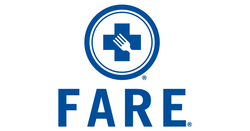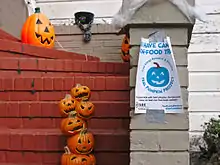Food Allergy Research & Education
Food Allergy Research & Education (FARE) is a non-profit organization dedicated to food allergy awareness, education, research, and advocacy; the organisation provides information, programs, and resources about food allergies and anaphylaxis. FARE was founded in 1991[3] to serve as a clearinghouse for food allergy information, by a parent whose own daughter was diagnosed with milk and egg allergy.
 | |
| Founded | 1991 |
|---|---|
| Focus | Food allergies |
| Location |
|
Area served | United States |
| Method | Education, Awareness, Research, Advocacy |
Members | Approx. 30,000[1] |
Revenue | $5,887,477 USD (2008) |
| Website | www |
The McLean, Va.-based organization has approximately 23,000 members in the U.S. and overseas.[1] Members include individuals, families, health care professionals, school and camp staff, child care providers, corporations, policymakers, organizations, institutions, and members of the pharmaceutical and food industries.
Information disseminated by FARE, is reviewed for accuracy by its Medical Advisory Board,[4] composed of medical professionals in the area of food allergy science.
On October 24, 2012, the Food Allergy & Anaphylaxis Network (FAAN) and the Food Allergy Initiative (FAI) merged to form Food Allergy Research & Education (FARE).[5]
In early 2010, FARE received a 4-star rating from Charity Navigator for sound fiscal management, for the third year in a row. FAAN's activities are centered on its four mission points: to raise public awareness, to provide advocacy and education, and to advance research on behalf of those affected by food allergy and anaphylaxis.[1]
Awareness
Through media,[6] and awareness programs,[7] FARE helps people better understand the daily challenges of managing food allergies. FARE's Ambassadors include:
- Frank Dicopoulos — participated in FARE's Walk for Food Allergy event in Long Branch, NJ.[8]
- Chris Dodd — Senator (D-Conn.) until 2011 has been working with FARE to educate others about food allergies. Sen. Dodd is co-sponsor of the Food Allergy and Anaphylaxis Management Act.[9]
- Adam Pascal — recording artist and Broadway star who believes in families educating themselves as best as they can about food allergies.[10]
- Ming Tsai — worked extensively with FARE to advocate for individuals with food allergies in restaurants.[11]
- Trace Adkins — country music star who served as the 2010 National Honorary Chair for FARE's Walk for Food Allergy.
In 2010, 37 states recognized Food Allergy Awareness Week,[12] an initiative FARE began in 1998, with official proclamations. The organization has also raised awareness through numerous newspaper and magazine articles, television reports, and fundraising events across the U.S., such as the Walk for Food Allergy: Moving Toward a Cure.[13]
Advocacy

FARE advocates for national, state and local policies that have a positive impact on members of the food allergy community. On the national level, FARE was instrumental in passing the Food Allergen Labeling and Consumer Protection Act (FALCPA) over the objections of large food manufacturers,[14] in 2004. As a result of FALCPA, the presence of major food allergens (milk, egg, wheat, soy, fish, shellfish, peanuts, and tree nuts) must be indicated, in simple terms, on packaged food items. At the state level, FARE has helped enact policies in more than 30 states that make epinephrine (adrenaline) more available from Emergency Medical Services, has helped create food allergy management guidelines for schools in more than ten states,[15] and spearheaded a new law in Massachusetts designed to help raise awareness of food allergy among restaurant staff.[16] On a local level, FARE has helped summer camps, child care centers, recreational facilities, colleges/universities, and public/private schools develop policies and approaches with the food allergy community in mind.
In 2014, FARE started the Teal Pumpkin Project, where families participating in Halloween signal that they have alternative treats available for people with allergies by placing a teal pumpkin or a flyer from the FARE website at their door.
Research
There are presently no known cures for food allergies, but research is being conducted throughout the world to find cures or therapies for food allergies. Since the inception of its donor-funded Research Grant Program,[17] FARE has committed more than $4.6 million to scientists studying various areas of food allergy and anaphylaxis.[18] FARE has partnered with the National Institutes of Health/National Institute of Allergy and Infectious Diseases to fund the Exploratory Investigations in Food Allergy program to encourage researchers to move into the field of food allergy.
The Food Allergy & Anaphylaxis Alliance
FARE is the founding member of the Food Allergy & Anaphylaxis Alliance,[19] an international alliance of patient education groups that collaborate on food allergy issues from a more global perspective. In 2010, the Alliance held its tenth annual meeting, and attracted participation from both the World Health Organization and the World Allergy Organization. Currently, the Alliance comprises 14 members representing 13 countries.
See also
References
- About FAAN
- FAAN Fact Sheet Archived 2 February 2011 at WebCite
- Medical Advisory Board Archived 2 February 2011 at WebCite
- "Financials | Food Allergy Research & Education".
- FARE Media Center Archived 2 February 2011 at WebCite
- Awareness Archived 2 February 2011 at WebCite
- Frank Dicopoulos Archived 2 February 2011 at WebCite
- Dodd Family Connection Archived 2 February 2011 at WebCite
- Adam Pascal Archived 2 February 2011 at WebCite
- Ming Tsai Archived 2 February 2011 at WebCite
- Food Allergy Awareness Week Archived 2 February 2011 at WebCite
- FAAN Walk for Food Allergy Archived 2 February 2011 at WebCite
- Food Allergen Labeling and Consumer Protection Act of 2004 Archived 2 February 2011 at WebCite
- Statewide Guidelines for Schools Archived 2 February 2011 at WebCite
- Massachusetts Food Allergy Awareness in Restaurants Archived 2 February 2011 at WebCite
- FAAN's Competitive Research Grant Program Archived 2 February 2011 at WebCite
- FAAN Awards 2010 Research Grants Archived 2 February 2011 at WebCite
- FAAA Goals & Accomplishments Archived 2 February 2011 at WebCite